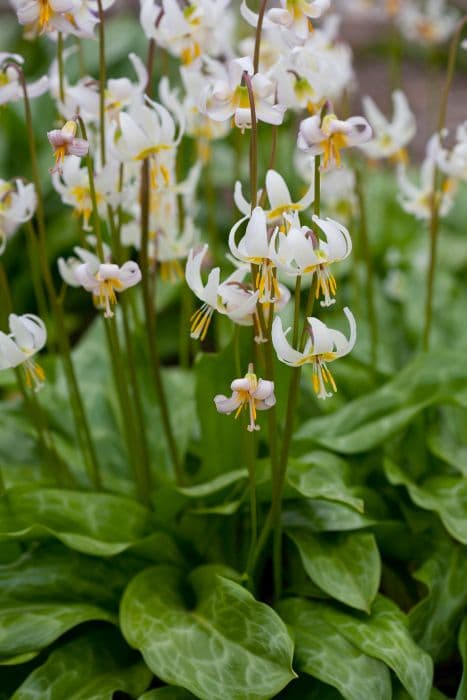Tiger Lily Lilium lancifolium (Ixc/d)

ABOUT
The plant known as the tiger lily displays a vibrant and striking appearance. It typically boasts large, showy flowers that are known for their fiery orange color, often speckled with black dots, which contribute to its common name. The petals are curved backward, giving them a turban-like shape, and they tend to be quite luscious and smooth to the touch. The flowers grow at the top of tall and sturdy stems, and they tend to face downward, as if the bloom is nodding towards the ground. Around the base of these conspicuous flowers, you would find long, green leaves that are narrow and lance-shaped, arranged in a spiral pattern along the stem and offering a lush, contrasting backdrop to the vivid flowers. Amidst the petals, prominent long stamens protrude outward, adding an elegant and wild aspect to the overall demeanor of the bloom. The stamens are tipped with anthers that carry pollen, which can be seen dusting the petals on occasion. Beneath the soil, the plant's underground parts consist of bulb scales, layered much like an artichoke, helping it to survive various conditions and re-emerge year after year. Though not visible, this bulb is a critical aspect of the plant's life cycle and its ability to proliferate in gardens and wild spaces alike. The entirety of the tiger lily makes it a beloved plant in gardens and cultural symbolism, famous for its exuberant display of color and form. Its robust presence and the way it sways gently in the breeze make it a captivating and popular choice for many plant enthusiasts.
About this plant
 Names
NamesFamily
Liliaceae
Synonyms
Tiger Lily, Devil Lily, Leopard Lily, Tigrinum Splendens
Common names
Lilium tigrinum, Lilium leopoldii, Lilium fortunei, Lilium lancifolium var. fortunei, Lilium lancifolium var. splendens.
 Toxicity
ToxicityTo humans
The most common name for Lilium lancifolium is Tiger Lily. This plant is considered toxic to humans if ingested, especially the bulb. It contains compounds like steroidal glycosides which can cause gastrointestinal discomfort. Symptoms of poisoning may include nausea, vomiting, diarrhea, abdominal pain, and in rare cases, it can lead to more severe effects such as heart rhythm abnormalities or kidney failure if large quantities are consumed. Handling the plant may also cause skin irritation or allergic reactions in some individuals.
To pets
The Tiger Lily is highly toxic to cats and can lead to acute kidney failure. Even ingesting small amounts such as a few petals or leaves, or the pollen can be extremely harmful and potentially fatal. Symptoms of poisoning in pets, particularly cats, include vomiting, lethargy, lack of appetite, increased urination followed by a lack of urination after 1-2 days, dehydration, and possible seizures. Immediate veterinary attention is required if ingestion is suspected. Dogs and other pets are less affected, but ingestion may still cause mild gastrointestinal upset.
 Characteristics
CharacteristicsLife cycle
Perennials
Foliage type
Deciduous
Color of leaves
Green
Flower color
Orange
Height
3-4 feet (0.9-1.2 meters)
Spread
1-2 feet (0.3-0.6 meters)
Plant type
Bulb
Hardiness zones
3-9
Native area
Asia
Benefits
 General Benefits
General Benefits- Ornamental Value: The Lilium lancifolium, commonly known as the Tiger Lily, is highly valued for its striking orange flowers with black spots, which can enhance the aesthetic appeal of gardens and landscapes.
- Pollinator Attraction: Tiger Lilies are known to attract beneficial pollinators such as bees, butterflies, and hummingbirds, supporting local ecosystems.
- Edible Parts: Certain parts of the Tiger Lily, such as the bulbs, are edible and can be used in cuisine, particularly in some Asian dishes.
- Cultural Significance: The Tiger Lily is associated with various cultural meanings and symbolisms, such as wealth, positivity, and pride, playing a role in cultural traditions and practices.
- Easy to Grow: Tiger Lilies are relatively easy to cultivate and can thrive in a variety of soil types, making them accessible to gardeners of different skill levels.
- Drought Tolerance: Once established, Tiger Lilies are fairly drought-tolerant, requiring minimal watering and maintenance under the right conditions.
 Medical Properties
Medical Properties- Anti-inflammatory: Some compounds in Lilium lancifolium, like phenolic acids, have been studied for their potential anti-inflammatory properties.
- Antitumor: Research has indicated that certain extracts from Lilium lancifolium may possess antitumor activities.
- Immunomodulatory: Components found in the plant may influence immune system responses.
- Antioxidant: Lilium lancifolium contains antioxidants that can neutralize harmful free radicals in the body.
- Neuroprotective Effects: Studies suggest that bioactive compounds in the plant might protect against neurodegenerative diseases.
 Air-purifying Qualities
Air-purifying QualitiesThis plant is not specifically known for air purifying qualities.
 Other Uses
Other Uses- Tiger lily bulbs are edible and can be used in cooking, often treated like potatoes or used in Asian cuisine.
- The flowers can be used as a natural dye, providing a yellow to orange color for fabrics.
- In certain cultures, the tiger lily is used symbolically in weddings to represent wealth and prosperity.
- The petals of the tiger lily are sometimes candied or used as an elegant garnish for desserts.
- The plant is considered to have allelopathic properties, where it can inhibit the growth of certain other plants nearby.
- Tiger lily stems can be used in traditional basket weaving practices due to their strength and flexibility after being properly treated.
- The plant's nectar, while not commonly collected, can be used as a sweet addition to certain culinary recipes.
- Tiger lilies are used in floral arrangements and professional landscaping for their vibrant and attractive appearance.
- Dried tiger lily flowers can be used in potpourri mixes to add color and a mild fragrance to a room.
- In some cultural ceremonies, tiger lily flowers are floated on water surfaces to create aesthetically pleasing displays.
Interesting Facts
 Feng Shui
Feng ShuiThe Tiger Lily is not used in Feng Shui practice.
 Zodiac Sign Compitability
Zodiac Sign CompitabilityThe Tiger Lily is not used in astrology practice.
 Plant Symbolism
Plant Symbolism- Purity: In many cultures, the Tiger Lily is often associated with purity due to its bright and prominent flowers.
- Prosperity: The abundant and vigorous growth of the Tiger Lily symbolizes prosperity and plentiful bounty.
- Pride: The striking appearance of the Tiger Lily can represent pride or confidence in one's abilities.
- Motherhood: In some traditions, the Tiger Lily is a symbol of motherhood, likely due to its rich and nurturing appearance.
 Water
WaterThe Tiger Lily (Lilium lancifolium) should be watered deeply whenever the top inch of soil feels dry to the touch. In general, this means watering once or twice a week depending on weather conditions. It is essential not to overwater these plants as they do not like to sit in waterlogged soil. During the active growing season in spring and summer, a rough estimate on the amount would be about 1 to 1.5 gallons of water per week for outdoor plants, adjusted for rainfall. In the fall and winter months, reduce watering as the plant goes dormant.
 Light
LightTiger Lilies prefer a spot where they can receive full sun for at least six hours a day. They thrive in bright, direct sunlight but can also tolerate partial shade, especially in the hottest parts of the day or in very warm climates. Ensure to choose an area that gets the morning sun, as this is the ideal lighting condition for them.
 Temperature
TemperatureThe ideal temperature range for Tiger Lilies is between 60 to 75 degrees Fahrenheit. They can tolerate a maximum temperature up to around 85 degrees Fahrenheit and a minimum temperature down to about -20 degrees Fahrenheit when dormant in the soil. However, sustained temperatures below freezing while the plant is actively growing can be damaging, so it's important to plant them at the right time in the spring after the chance of frost has passed.
 Pruning
PruningPruning Tiger Lilies is done mainly to remove dead or diseased flowers and foliage, as well as to help control their spread and encourage more blooms in the following season. Deadhead spent flowers after blooming and cut back stems to the ground level once they have yellowed in the fall. Pruning is typically done annually after flowering and again at the end of the growing season.
 Cleaning
CleaningAs needed
 Soil
SoilThe Tiger Lily thrives in well-drained, loamy to sandy soil enriched with organic matter. Aim for a slightly acidic to neutral pH, between 5.5 and 6.5. A mix of two parts loam, one part peat moss, and one part perlite or sand is ideal to facilitate proper drainage and root development.
 Repotting
RepottingTiger Lilies should typically be repotted every 2-3 years to refresh the soil and accommodate the growth of the bulbs. Overcrowded bulbs may require more frequent repotting to prevent stunted growth or inadequate blooming.
 Humidity & Misting
Humidity & MistingTiger Lilies prefer moderate humidity, around 40-60%. They can tolerate some variation, but consistent humidity within this range is optimal for the plant's health.
 Suitable locations
Suitable locationsIndoor
Place tiger lily near a sunny window; water when topsoil feels dry.
Outdoor
Plant in well-drained soil, full sun to part shade; water deeply once a week.
Hardiness zone
3-9 USDA
 Life cycle
Life cycleLilium lancifolium, commonly known as tiger lily, begins its life cycle as a bulb, which remains dormant during the winter. In spring, the bulb sprouts stems and leaves, with the plant harnessing energy through photosynthesis. As the season progresses, the tiger lily enters its flowering stage, typically in mid to late summer, producing vibrant orange flowers with dark spots. After pollination, potentially by insects, the flowers produce seeds, which can be dispersed by wind or animals. Once the flowers have withered, the plant's above-ground parts begin to die back, while the bulb underground stores energy for the next growing season. The cycle repeats when the bulb enters another period of dormancy until the following spring.
 Propogation
PropogationPropogation time
Spring-Early Summer
The most popular method of propagation for the Tiger Lily (Lilium lancifolium) is by using its bulbils. Bulbils are tiny bulbs that can form in leaf axils on the stem of the plant. These bulbils can be harvested in late summer once they mature and have turned a dark color. Gardeners can carefully pluck the bulbils from the stem and plant them in well-draining soil at a depth of approximately 2 inches (about 5 centimeters), spacing them about 4 to 6 inches apart (10 to 15 centimeters). In the following spring, the planted bulbils will sprout and eventually grow into new flowering plants. This method is simple and cost-effective, allowing for a large number of new plants to be grown from a single parent plant.









